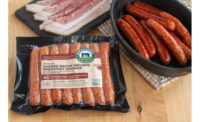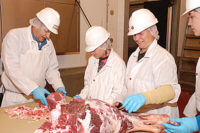Sausage Invades The U.S.
By Lynn Petrak, Special Projects Editor
Sausage Masters from around the world bring their recipes and skills to this country and launch a new, growing market for this time-tested delicacy.
Many of them have come from overseas, immigrating to the United States for new opportunities at a time of food industry expansion. Most, if not all, have storied pasts that they don’t mind sharing along with their rich experience in the field. Several still have a literal hand in day-to-day production, while others have turned to consulting. A few have retired, having passed on their craft to the next generation.
Meet the Sausage Masters, the men (and some women) whose deft skills and marked devotion to their craft distinguishes them and elevates them to the rank of the extraordinary. Their task is no easy one, to be sure. “Sausage making is pretty hard work,” points out Herbert Ockerman, a professor of animal science and sausage expert at The Ohio State University.
Steve Krut, executive director of the American Association of Meat Processors (AAMP), agrees that there is no simple job description for a sausage master. “It becomes everything from the recipes and development to maintaining the integrity of the recipes to understanding that it isn’t just dependent on what you put in, but on maintenance and equipment – is the blade sharp, is the product cool before you grind it?” he asks, adding that in addition to formulas and processes, Masters are also well-versed on livestock production, meat processing, packaging, and marketing.
The Masters themselves likely would agree with the assessment that their work is truly unique, one reason they are sought after by consumers and consulted by others in the industry. “There is an art to it,” asserts Klaus Benz, a German native and formally-trained sausage master who now works as a sales manager and technical expert for equipment supplier Poly-clip System, Mundelein, IL.
Likewise, Bruce Aidells, a French-trained chef from California who turned his passion for sausage making to a successful national brand of gourmet sausage under his name, says that superior sausage making involves continually learning new things and taking time to do it right in a world where the pace is so demanding. “It’s about going back hundreds of years in the way sausages were made. Less is better than more, and it doesn’t involve any additional chemicals -- just basic ground meat and spices,” he offers.
Given the fact that there are so many sausage products sold in the U.S., it shouldn’t be surprising that sausage masters can be found throughout this country, running a nearby butcher shop, overseeing the line at a leading sausage brand plant, or acting as an industry liaison between suppliers and meat companies, among other roles.
As anyone who has enjoyed the distinct “snap” and savory taste of a superb sausage can tell you, not all sausages are created equal. The links, rings, patties, and chubs made by a Master are likely to be made from quality cuts of meat (usually pork or beef, but also lamb, veal, and poultry) with a carefully combined balance of seasonings, salt, and fat.
That’s not to say that a sausage master wouldn’t use a flavor extract or fillers, since some do experiment with different methods and take advantage of modern food science. But by and large, with few exceptions, sausage masters are famous for their extensive and formal experience, their unique recipes that never skimp on quality, and their diligence that is often combined with marketing and customer-service savvy.
In this special issue of THE NATIONAL PROVISIONER, we introduce readers to a group of Sausage Masters who have made a name for themselves through their craft. A majority of these individuals have been recognized for their work through awards and distinctions. Others, like Aidells, have found success in sausage-making companies that have grown to become key national and sometimes even international players.
Perhaps even more importantly, they are not wary of sharing their expertise with others, or holding onto sausage-making secrets so tightly that the secrets will vanish when they do. Sausage masters are also considered masters because of their significant role and leadership within the industry.
In this autumn season, when sausages emerge once again as a beloved part of menus all around the world, it’s an appropriate time to showcase the Sausage Masters, as well as their products, background, philosophies about the industry and the history -- and significance of the sausage itself.
The stuff on sausage
To get a sense of perspective of how today’s Sausage Masters continue traditions that date back decades if not centuries, it is helpful to take a quick history lesson on the humble sausage, as well as a brief review of sausage-making techniques.
Believe it or not, it didn’t take long to discover that seasoned, chopped-up meat was a good thing. After our ancestors began hunting animals for food, they realized they had to preserve their bounty and found that salt was an effective tool for preservation. In fact, the term “sausage” is derived from the Latin word “salsus”, which means “salted.”
Preserving meat through salt was practiced for generations. Eventually, locally-available seasonings were added, such as herbs and ground or chopped spices. Early sausage makers also began using a variety of domesticated animals that were in their geographical area for meat.
Historical studies show that sausages were eaten in Rome, while ways of making sausages were actually mentioned in Homer’s classic “Odyssey” in the Eighth Century, B.C. Although sausage making was, even back then, a European specialty, hogs were domesticated in Asia, where the Chinese are believed to have made sausage-related products as far back as 4,000 B.C.
In the first millennium A.D., it was in Europe where sausage making began to become a true trade, rather than a way to produce food merely to satisfy hunger. In France, sausage making was part of the practice of artfully creating meats known as charcuterie, a term still used in France and elsewhere to describe a sausage store or deli. Those experienced in the practice of charcuterie became somewhat of a legend in that nation.
Across the way in Germany, sausage making was flourishing as a craft as well. Regional specialties of sausages abounded, and within each region, families made a name for themselves by their own recipes. German sausage meisters devised early formulations for some of the world’s favorite sausages, and it was in Frankfurt where the original frankfurter was said to have been invented.
The case can be made that it was in Paris, though, that the notion of a Sausage Master took root.
Those who contend that the U.S. meat industry is overly regulated today might be intrigued to learn that the sausage has always been under the regulatory microscope, well before the first shot of the Revolutionary War was fired. It was in 1475 that formal laws were enacted to govern the preparation of sausage products in Paris, and the move helped launch a class of charcuterie “masters” certified to handle pork and other products. The French government at the time saw the distinction as a way to help regulate product handling, preparation, cooking, and selling.
Meanwhile, as sausage making began to evolve as a true craft in Europe, its popularity expanded to all corners of the globe. Explorers from the 1400s through the 1700s brought along sausages with them on their travels because it was a satisfying, portable food (and you thought portability was just a contemporary consumer demand!). As explorers set about their journeys, they introduced sausages to the locals, and it wasn’t long before different combinations of meats and ingredients were tried in those places.
As the charcuterie masters in France and the sausage experts in Germany, Italy, and later the United Kingdom countries of England, Scotland, and Ireland kept at their trade, a few standards about the preparation process began to develop the basics, which are still followed today in the 21st century.
First of all, it was learned early on that the balance of meat and fat is critical in sausage taste and mouthfeel, with a 70:30 ratio determined to be the preferred standard. Early sausage makers also discovered that salt, a bit of water, or some other type of flavorful liquid (like beer in Germany), were effective when combined with meat and the seasonings of choice, whether it be paprika, garlic, peppers, or other ingredients. In later years, nitrates and nitrites were added to extend shelf life for dried sausages.
Early standards for sausage making also covered processing techniques. Cold environments were deemed best, and clean equipment was said to be important (again, a foreshadowing of the modern manufacturing environment) for wholesome and proper preparation of the product.
Such rules were brought with butchers and sausage makers when they came to America, many of them from the sausage bastions of Europe. In the 18th and early 19th century in this country, those sausage makers began to grind out their trademark foodstuffs in cities and towns in U.S. as part of their own thriving meat businesses.
Before long, regional preferences sprung up in U.S., mirroring such trends in the sausage makers’ home countries. “It’s amazing, really, how the ethnic groups formed small communities, and people here like what they grew up with,” relays Ockerman, citing certain types of sausages that may be staples in Wisconsin, but not in New York, and vice versa.
A review of sausage products today (see sidebar on “Know Your Sausages”) demonstrates the significance and perseverance of regional preferences. Consumers still go for their favorites but are willing to try new ethnic tastes, which is why stores and markets still sell Cotto Salami from Italy, Braunschweiger from Germany, potato sausage from Ireland, and Chorizo from Mexico, to name some examples.
Many Sausage Masters in America continue to produce their family recipes in earnest, whether their relatives came from Ireland or the Bavarian region of Germany, mixing up the same formulations with pride. At the same time, the surge in popularity of gourmet sausages has not gone unnoticed, and even the Masters are getting creative and trying their hand at new flavors and forms. Once again, the sausage, and with it the class of experts, is evolving. NP



Report Abusive Comment